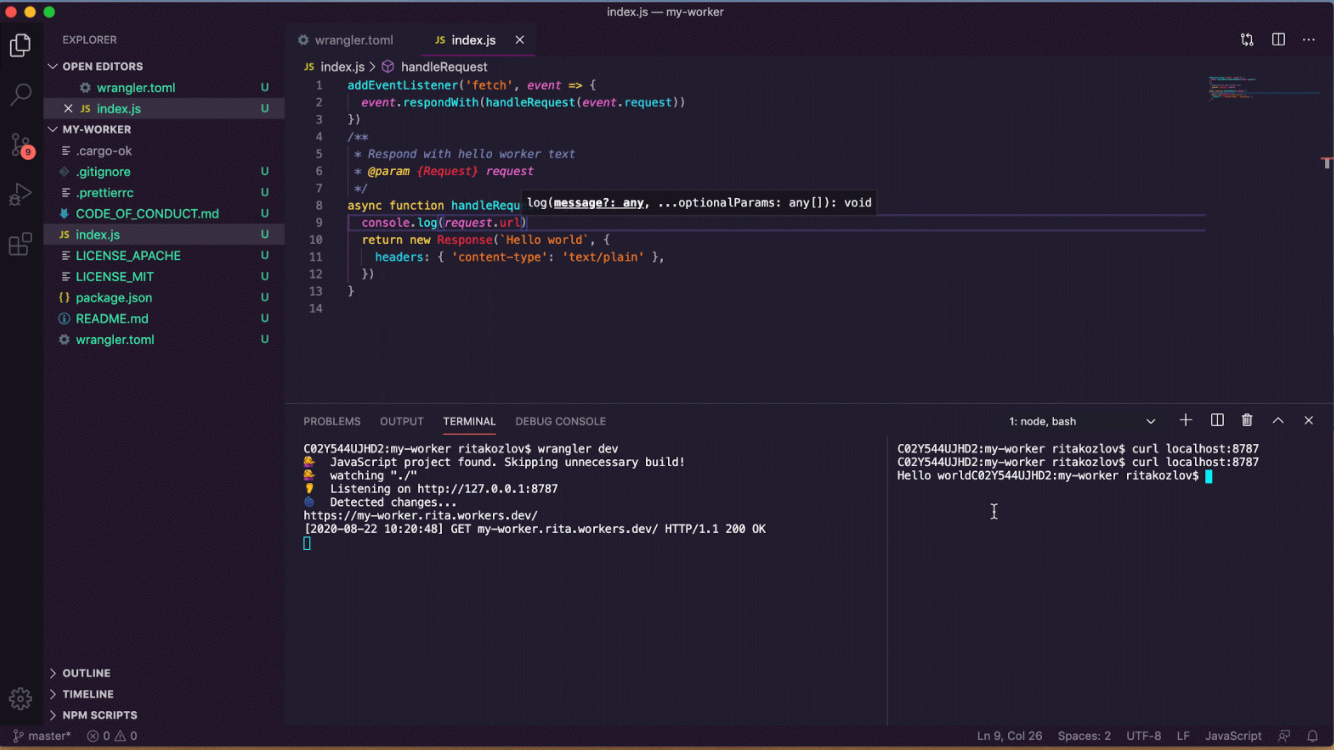Announcing wrangler dev — the Edge on localhost

Cloudflare Workers — our serverless platform — allows developers around the world to run their applications from our network of 200 datacenters, as close as possible to their users.
A few weeks ago we announced a release candidate for wrangler dev — today, we're excited to take wrangler dev, the world’s first edge-based development environment, to GA with the release of wrangler 1.11.
Think locally, develop globally
It was once assumed that to successfully run an application on the web, one had to go and acquire a server, set it up (in a data center that hopefully you had access to), and then maintain it on an ongoing basis. Luckily for most of us, that assumption was challenged with the emergence of the cloud. The cloud was always assumed to be centralized — large data centers in a single region (“us-east-1”), reserved for compute. The edge? That was for caching static content.
Again, assumptions are being challenged.
Cloudflare Workers is about moving compute from a centralized location to the edge. And it makes sense: if users are distributed all over the globe, why should all of them be routed to us-east-1, on the opposite side of the world, Continue reading
Docker Swarm Services behind the Scenes
Remember the claim that networking is becoming obsolete and that everyone else will simply bypass the networking teams (source)?
Good news for you – there are many fast growing overlay solutions that are adopted by apps and security teams and bypass the networking teams altogether.
That sounds awesome in a VC pitch deck. Let’s see how well that concept works out in reality using Docker Swarm as an example (Kubernetes is probably even worse).
Implementing IP’s Longest Prefix Match in Pandas
Longest Prefix Match (LPM) is the algorithm used in IP networks to forward packets. The algorithm is used to select the one entry in the routing table (for those that know, I really mean the FIB–forwarding information base–here when I say routing table) that best matches the destination address in...Webinar: How the Internet Really Works
My next upcoming live webinar on Safari Books is How the Internet Really Works. This was originally a three-hour webinar which I’ve added some material to so it’s now four hours… I’m working with Pearson to add further material and break this into two three-hour webinars, so this will probably be the last four-hour version of this I teach.
Technologies that Didn’t: The Fiber Distributed Data Interface
Token Ring, in its original form, was—on paper—a very capable physical transport. For instance, because of the token passing capabilities, it could make use of more than 90% of the available bandwidth. In contrast, Ethernet systems, particularly early Ethernet systems using a true “single wire” broadcast domain, cannot achieve nearly that kind of utilization—hence “every device on its own switch port.” The Fiber Distributed Data Interface, or FDDI, is like Token Ring in many ways. For instance, FDDI uses a token to determine when a station connected to the ring can transmit, enabling efficient use of bandwidth.
And yet, Ethernet is the common carrier of almost all wired networks today, and even wireless standards mimic Ethernet’s characteristics. What happened to FDDI?
FDDI is a 100Mbit/second optical standard based on token bus, which used an improved timed token version of the token passing scheme developed for token ring networks. This physical layer protocol standard had a number of fairly unique features. It was a 100Mbit/second standard at a time when Ethernet offered a top speed of 10Mbits/second. Since FDDI could operate over a single mode fiber, it could support distances of 200 kilometers, or around 120 miles. Because it was Continue reading
The State of Routing Security at DNS Registries

The Domain Name System (DNS) is an important component of the Internet, but it was not designed with security in mind. In the last 20 years or so, much attention has been directed at improving its inherently insecure aspects.
This includes the deployment of DNS Security Extensions (DNSSEC) that enables cryptographic validation of DNS records, and more recently DNS-over-TLS and DNS-over-HTTPS, which encrypts DNS transactions between hosts and resolvers.
The DNS, though, is also dependent on the global routing system for sending DNS queries from resolvers to servers, and then returning the responses. The integrity of the routing system is, therefore, extremely important for ensuring DNS transactions are delivered efficiently to the correct destination. Yet, at present, few DNS registries are implementing Routing Public Key Infrastructure (RPKI), a public key infrastructure framework designed to secure the Internet’s routing infrastructure, specifically the Border Gateway Protocol (BGP).
A survey of 4,138 zones – that included 1,201 generic top-level domains (gTLDs), 308 country code top-level domains (ccTLDs), 271 reverse map zones, and 1,780 sub-ccTLD zones – showed a total of 6,910 route origins for the name servers that are serving these zones.
Yet, just 22% of these had valid Route Origin Authorisations (ROA), Continue reading
Improving the Wrangler Startup Experience


Today I’m excited to announce wrangler login, an easy way to get started with Wrangler! This summer for my internship on the Workers Developer Productivity team I was tasked with helping improve the Wrangler user experience. For those who don’t know, Workers is Cloudflare’s serverless platform which allows users to deploy their software directly to Cloudflare’s edge network.
This means you can write any behaviour on requests heading to your site or even run fully fledged applications directly on the edge. Wrangler is the open-source CLI tool used to manage your Workers and has a big focus on enabling a smooth developer experience.
When I first heard I was working on Wrangler, I was excited that I would be working on such a cool product but also a little nervous. This was the first time I would be writing Rust in a professional environment, the first time making meaningful open-source contributions, and on top of that the first time doing all of this remotely. But thanks to lots of guidance and support from my mentor and team, I was able to help make the Wrangler and Workers developer experience just a little bit better.
The Problem
The main improvement Continue reading
Worth Reading: Hardware Packet Capture Failures
Greg Ferro is back with some great technical content, this time explaining why hardware-based packet capture might return unexpected results.
What’s the Big Deal About Multi-Cloud Networking – Part 2
If you were experiencing issues with Zoom calls today, you were not alone. But if you take a close look at today’s outage, it is clear that it was correlated with an AWS outage today. In fact, most of Zoom runs on AWS, according to AWS. This is despite Oracle’s claim that millions of users … Continue reading What’s the Big Deal About Multi-Cloud Networking – Part 2New Livelesson: Understanding Network Transports
Safari Books Online just published my latest Livelesson—eight hours of technical yet fundamental training on network transports. I co-authored this one with Ethan Banks (yes, that Ethan Banks). I consider this video series a compliment to the transport chapters in Computer Networking Problems and Solutions.
If you ever wanted to really understand transport protocols … this is your chance.
The White Board and the Simulation
In the argument between OSPF and BGP in the data center fabric over at Justin’s blog, I am decidedly in the camp of IS-IS. Rather than lay my reasons out here, however (a topic for another blog post?), I want to focus on something else Justin said that I think is incredibly important for network engineers to understand.
I think whiteboards are the most important tool for network design currently available, which makes me sad. I wish that wasn’t true, I want much better tools. I can’t even tell you the number of disasters averted by 2-3 great network engineers arguing over a whiteboard.
I remember—way back—when I was working on the problems around making a link-state protocol work well in a Mobile Ad Hoc Network (MANET), we had two competing solutions presented to the IETF. The first solution was primarily based on whiteboarding through various options and coming up with one that should reduce flooding to an acceptable level. The second was less optimal on the whiteboard but supported by simulations showing it should reduce flooding more effectively.
Which solution “won?” I don’t know what “winning” might mean here, but the solution designed on the whiteboard has Continue reading
Network Break 298: Arista Launches CloudVision As A Service; Cisco, Megaport Partner On SD-WAN
Take a Network Break! Pass around the virtual pickles as we delve into Arista's new SaaS version of CloudVision, Cisco and Megaport's SD-WAN partnership, new Intent-Based Networking features from Apstra, and more tech news.
The post Network Break 298: Arista Launches CloudVision As A Service; Cisco, Megaport Partner On SD-WAN appeared first on Packet Pushers.
Network Break 298: Arista Launches CloudVision As A Service; Cisco, Megaport Partner On SD-WAN
Take a Network Break! Pass around the virtual pickles as we delve into Arista's new SaaS version of CloudVision, Cisco and Megaport's SD-WAN partnership, new Intent-Based Networking features from Apstra, and more tech news.The Week in Internet News: Facebook Bans Conspiracy Accounts

Ban hammer: Facebook has banned banned about 900 pages and groups and 1,500 ads tied to the conspiracy theory QAnon, NBC News reports. QAnon followers believe an anonymous, supposed government insider has warned them about a massive group of satanic cannibals and pedophiles inside the U.S. government. QAnon, militia movements, and violent movements tied to protests will no longer be allowed to buy ads on Facebook, the social media giant said.
That’s really fast: Researchers from University College London have been able to transmit data at 178 terabits per second, The Independent says. That speed is double the speed of any current system being used, and about 20 percent faster than the previous record. With that speed, an Internet user could download the entire Netflix library in just one second.
Cracks in the ‘Net: U.S. President Donald Trump’s campaign against Chinese services TikTok and WeChat could further fracture the Internet, the New York Times reports. “China and the United States once acted like opposites when it came to governing the internet … When President Donald Trump issued executive orders that could lead to a U.S. ban next month on two of the world’s most popular Chinese-made apps, TikTok Continue reading
Delivering HTTP/2 upload speed improvements


Cloudflare recently shipped improved upload speeds across our network for clients using HTTP/2. This post describes our journey from troubleshooting an issue to fixing it and delivering faster upload speeds to the global Internet.
We launched speed.cloudflare.com in May 2020 to give our users insight into how well their networks perform. The test provides download, upload and latency tests. Soon after release, we received reports from a small number of users that sometimes upload speeds were underreported. Our investigation determined that it seemed to happen with end users that had high upload bandwidth available (several hundreds Mbps class cable modem or fiber service). Our speed tests are performed via browser JavaScript, and most browsers use HTTP/2 by default. We found that HTTP/2 upload speeds were sometimes much slower than HTTP/1.1 (assuming all TLS) when the user had high available upload bandwidth.
Upload speed is more important than ever, especially for people using home broadband connections. As many people have been forced to work from home they’re using their broadband connections differently than before. Prior to the pandemic broadband traffic was very asymmetric (you downloaded way more than you uploaded… think listening to music, or streaming a movie), Continue reading